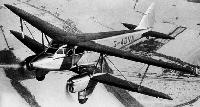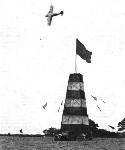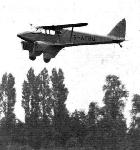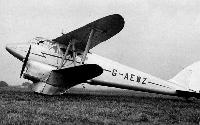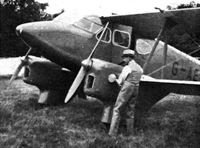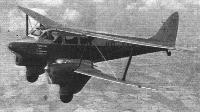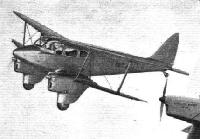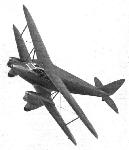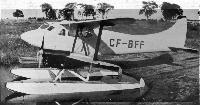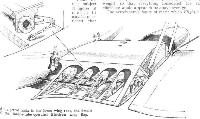
Описание
Страна : Великобритания
Год : 1935
Легкий транспортный самолет с экипажем из одного человека
Варианты
- De Havilland - Dragon / D.H.84 - 1932 - Великобритания
- Breda - Ba.44 - 1934 - Италия
- De Havilland - Dragon Rapide / Dominie / D.H.89 - 1934 - Великобритания
- Farman - F.430 - 1934 - Франция
- De Havilland - Dragonfly / D.H.90 - 1935 - Великобритания
- De Havilland - Dolphin / D.H.92 - 1936 - Великобритания
de Havilland DH.90 Dragonfly
Самолет DH.90 Dragonfly, внешне очень похожий на DH.89 Dragon Rapide, сильно отличался от него по конструкции. Его фюзеляж представлял собой предварительно отформованный фанерный монокок, усиленный деревянными стрингерами. Усиленная конструкция центроплана нижнего крыла позволила отказаться от подкосов между крылом и стойками шасси, а также внутренних растяжек, что облегчило доступ в кабину, рассчитанную на одного пилота и четырех пассажиров. Прототип, оснащенный двигателями Gipsy Major, совершил первый полет в Хэтфилде 12 августа 1935 года. Первый серийный DH.90A, на который установили двигатели Gipsy Major II, поднялся в воздух в феврале 1936 года. Всего построили 66 самолетов, в том числе и для военных ведомств Канады, Дании и Швеции.
ТАКТИКО-ТЕХНИЧЕСКИЕ ХАРАКТЕРИСТИКИ
de Havilland DH.90A Dragonfly
Тип: легкий транспортный самолет с экипажем из одного человека
Силовая установка: два рядных поршневых двигателя de Havilland Gipsy Major II мощностью 130 л. с. (97 кВт)
Летные характеристики: максимальная скорость на оптимальной высоте 232 км/ч; крейсерская скорость на оптимальной высоте 201 км/ч; начальная скороподъемность 223 м/мин; потолок 5515 м; дальность полета 1006 км
Масса: пустого 1128 кг; максимальная взлетная 1814 кг
Размеры: размах крыльев 13,11 м; длина 9,65 м; высота 2,79 м; площадь крыльев 23,78 м2
Полезная нагрузка: до четырех пассажиров в закрытой кабине
Описание:
- de Havilland DH.90 Dragonfly
- Flight, January 1936
THE D.H. DRAGONFLY - Flight, March 1936
AN AMATEUR'S "TWINITIATION'' - Flight, April 1936
MODERN LIGHT AIRCRAFT REVIEWED
Фотографии
-
Aeroplane Monthly 1996-11
Регистрационный номер: G-AEDU [7] This unique formation, overflying Woburn Abbey during the de Havilland Moth Club's meeting on August 17-18, 1996, comprises Aer Lingus D.H.84 Dragon EI-ABI, Torquil Norman's D.H.90 Dragonfly G-AEDU and Philip Meeson's D.H.89A Rapide G-AGSH.
Другие самолёты на фотографии: De Havilland Dragon / D.H.84 - Великобритания - 1932De Havilland Dragon Rapide / Dominie / D.H.89 - Великобритания - 1934
-
Мировая Авиация 105
Регистрационный номер: G-ADNA [9] Хотя DH.90 пользовались спросом у частных владельцев, как в Великобритании, так и в других странах, большая часть этих машин была продана коммерческим операторам.
-
Flight 1936-12 / Flight Advertisements
Регистрационный номер: G-ADNA [9] -
Aeroplane Monthly 1982-03 / H.Scanlan - Dings with a Dragonfly
Регистрационный номер: G-ADNA [9] “One of the most exquisitely pretty aeroplanes ever drafted by the hand of man.”
-
Flight 1937-03 / Flight
Регистрационный номер: G-ADNA [9] For luxury ownership: The D.H. Dragonfly, aptly described as "an air liner in miniature," cruises at 127 m.p.h. for 885 miles with five occupants and their luggage.
-
Flight 1936-07 / Flight
Регистрационный номер: G-ADNA [9] The D.H. Dragonfly (the only biplane in the race) took its turns in grand style. This view also shows the nature of the Sacombe pylon.
-
Flight 1936-01 / Flight
Регистрационный номер: G-ADNA [9] "Throwing it About": Mr. H. Buckingham gives the D.H.90 a thorough try-out above the clouds.
-
Flight 1937-02 / Flight Advertisements
Регистрационный номер: G-ADNA [9] De Havilland Dragonfly. Cabin Aircraft for 5 persons and luggage. Two Gipsy Major 130 h.p. engines.
-
Flight 1936-03 / Flight Advertisements
Регистрационный номер: G-ADNA [9] -
Jane's All the World Aircraft 1938 / 03 - All the world's aeroplanes
Регистрационный номер: G-ADNA [9] The D.H. "Dragonfly" Five-seat Cabin Biplane (two 130 h.p. D.H. "Gipsy-Major" engines).
-
Flight 1936-07 / Flight
Регистрационный номер: G-AEBU The D.H. Dragonfly gave an impressive demonstration of flying with one engine stopped completely.
-
Flight 1936-08 / Flight
INSTRUCTIONAL FLEET: Now that the London Aeroplane Club have obtained their new D.H. Dragonfly for twin-engined training their instructional fleet is one of the most complete in the country. In this Flight photograph there will be seen the Dragonfly, two Hornet Moths and five of the six Tiger Moths. In the foreground (though not to be recognised) are Messrs. Rodwell, Harris, Goodyear and Maclaren, respectively secretary, chief instructor and assistant instructors.
Другие самолёты на фотографии: De Havilland Hornet Moth / D.H.87 - Великобритания - 1934De Havilland Tiger Moth / D.H.82 - Великобритания - 1931
-
Aeroplane Monthly 1988-09 / R.Riding - Dragonfly metamorphosis
Регистрационный номер: G-AEDT [19] The Dragonfly in its original colour scheme, complete with the 601 Sqn red flying sword on the fin. G-AEDT's owner was Sir Philip Sassoon, the squadron's Honorary Air Commodore.
-
Aeroplane Monthly 1988-05 / Personal album. Civil
Регистрационный номер: G-AEDT [19] Sir Philip Sassoon's D.H.90 Dragonfly G-AEDT seen at Lympne in 1936. Built in 1936, 'DT was sold to Australia in July 1938 to become VH-AAD. It returned to the UK in December 1963 but, after restoration at Shoreham, was flown to the USA, becoming N2034. In 1986 it was purchased by de Havilland aircraft collector Brian Woodford and was shipped to Ron Souch's workshops at Salisbury Green, Hampshire. It will shortly emerge, repainted in Sassoon's livery, complete with flying sword on the fin, hopefully in time for this year's de Havilland Moth Club rally at Woburn.
-
Aeroplane Monthly 1988-09 / R.Riding - Dragonfly metamorphosis
Регистрационный номер: G-AEDT [19] Charles Masefield and Lord Trefgarne pose for the press in front of the Dragonfly, now named Endeavour, at the time of their Australia-England flight in 1963.
-
Air-Britain Archive 1980-02
Регистрационный номер: G-AEDT [19] Dragonfly G-AEDT was one of the survivors and is shown here at Orange County Airport on 6.5.67, exactly 31 years after the first Application for C of A!
-
Aeroplane Monthly 1988-09 / R.Riding - Dragonfly metamorphosis
Регистрационный номер: G-AEDT [19] Masefield and Trefgarne taking off from Bankstown, NSW on December 1, 1963.
-
Aeroplane Monthly 1988-09 / R.Riding - Dragonfly metamorphosis
Регистрационный номер: G-AEDT [19] Ready for road transport to Lee-on-Solent for rigging.
-
Aeroplane Monthly 1988-08 / M.Oakey - Grapevine
Регистрационный номер: G-AEDT [19] Brian Woodford's de Havilland D.H.90 Dragonfly undergoing engine runs at Lee-on-Solent in mid-June 1988. Nearing the end of a 2yr restoration by Ron Souch, the aircraft should have flown by the time this issue is published.
-
Aeroplane Monthly 1988-09 / R.Riding - Dragonfly metamorphosis
Регистрационный номер: G-AEDT [19] The Dragonfly ready for its “first flight” on July 15 at Lee-on-Solent.
-
Aeroplane Monthly 1988-09 / M.Oakey - Grapevine
Регистрационный номер: G-AEDT [19] Brian Woodford's de Havilland D.H.90 Dragonfly G-AEDT at the Badminton Air Day on July 24, 1988.
-
Aeroplane Monthly 1988-09 / R.Riding - Dragonfly metamorphosis
Регистрационный номер: G-AEDT [19] De Havilland Dragonfly G-AEDT making its display-flying debut at Badminton on July 24, 1988.
-
Aeroplane Monthly 1988-09 / R.Riding - Dragonfly metamorphosis
Регистрационный номер: G-AEDT [19] The Dragonfly airborne on the afternoon of July 15, 1988 during its second post-restoration flight.
-
Aeroplane Monthly 1990-04 / ??? - Ah! Woburn
Регистрационный номер: G-AEDT [19] Brian Woodford’s Souch-restored D.H.90 Dragonfly, formerly VH-AAD, lands in the capable hands of Martin Barraclough.
-
Aeroplane Monthly 1988-09 / R.Riding - Dragonfly metamorphosis
Регистрационный номер: G-AEDT [19] -
Aeroplane Monthly 1988-09 / R.Riding - Dragonfly metamorphosis
Регистрационный номер: G-AEDT [19] ’DT once more carries the red flying sword of 601 Sqn on its fin, a reminder of its first, distinguished owner of more than half a century ago.
-
Aeroplane Monthly 1983-08 / P.Jarrett - Grapevine
Регистрационный номер: G-AEDU [7] De Havilland Dragonfly G-AEDU, bought by American millionaire property developer Charles A. Osborne of Louisville, Kentucky, at Christie’s Duxford auction, took off on June 10, 1983 on the first leg of its ferry flight to the USA. The aircraft, fitted with radio for the first time in its life, was piloted by American pilots Mike Simmons and Charles Shontz.
-
Aeroplane Monthly 1981-09 / ??? - PFA at Leicester
Регистрационный номер: G-AEDU [7] The world’s sole airworthy D.H.90 Dragonfly G-AEDU, has just been restored by Cliff Lovell for owners Martin Barraclough and Tony Haig Thomas and is seen arriving at Leicester.
-
Aeroplane Monthly 1985-05 / K.Desmond - Arthur E. Hagg
Регистрационный номер: G-AEDU [7] AIR PORTRAITS' superb photograph of D.H.90 Dragonfly G-AEDU and D.H.89A Dragon Rapide G-AHGD, photographed near Old Warden on June 27, 1982. Both aircraft were designed by Arthur Hagg. The Dragonfly, currently the only airworthy example of its breed, is now flying in the USA.
Другие самолёты на фотографии: De Havilland Dragon Rapide / Dominie / D.H.89 - Великобритания - 1934
-
АвиаМастер 2001-01 / В.Котельников - Драконово семейство /Крылатые долгожители/
Регистрационный номер: G-AEDU [7] "Дрэгонфлай", ранее принадлежавший южноафриканской авиакомпании, и английский военно-санитарный "Дрэгон Рапид".
Другие самолёты на фотографии: De Havilland Dragon Rapide / Dominie / D.H.89 - Великобритания - 1934
-
Aeroplane Monthly 1982-09
Регистрационный номер: G-AEDU [7] The de Havilland D.H.90 Dragonfly G-AEDU, jointly owned by Tony Haig-Thomas and Martin Barraclough, in formation with Michael Astor's D.H.89A Dragon Rapide G-AHGD, photographed near Old Warden on June 27, 1982 by AIR PORTRAITS.
Другие самолёты на фотографии: De Havilland Dragon Rapide / Dominie / D.H.89 - Великобритания - 1934
-
Мировая Авиация 220
Регистрационный номер: G-AEWZ [6] DH.90 Dragonfly (на фото) с фюзеляжем полумонококовой конструкции из дерева являлся уменьшенным вариантом Rapide, рассчитанным на пять пассажиров, и оснащался парой моторов DH Gipsy Major. В конечном итоге построили 67 самолетов DH.90.
-
Aviation Historian 40 / P.Marson - Southern charm
Регистрационный номер: G-AEWZ [6] Bellamy acquired D.H.90A Dragonfly G-AEWZ in 1949 and applied tiny Flightways titling on the nose, too small to be visible in this photograph taken at Eastleigh on August 6 that year. Originally operated as G-AEWZ by Air Service Training Ltd at Hamble before the war, it was impressed into RAF service as DJ716 in January 1941.
-
Air-Britain Archive 1981-01
Регистрационный номер: G-AEWZ [6] Dragonfly G-AEWZ of Silver City Airways at an event at Kidlington, probably in the late fifties. It too was scrapped in 1961, following a take-off accident at Elmdon on 3.3.61.
-
Jane's All the World Aircraft 1980 / Encyclopedia of Aviation - Aircraft A-Z - v3
Регистрационный номер: G-AEWZ [6] de Havilland D.H.90 Dragonfly.
-
Aviation Historian 40 / P.Marson - Southern charm
Регистрационный номер: G-AEWZ [6] Reunited with an old friend - Bellamy re-acquired Dragonfly G-AEWZ in 1960 and painted it in the Hampshire Aeroplane Club’s red, yellow and black colours, as seen here at Eastleigh. It was only a brief reunion, however, the Dragonfly moving on by the end of the year. It came to grief during a take-off accident at Elmdon in March 1961 and was damaged beyond repair.
-
Air-Britain Archive 1984-01
Регистрационный номер: G-AEWZ [6] Dragonfly G-AEWZ at Eastleigh where it was based, for the second time, from mid-1960 until it was written-off at Elmdon on 3.3.61
-
Flight 1938-07 / Flight
At DEAUVILLE: Air Marshal Joubert de la Ferte prepares to start his Dragonfly - actually the D.H. and London Club training and general communication machine.
-
Aeroplane Monthly 1982-11 / G.Alington - Stirling civil servants
Регистрационный номер: G-AIYJ The author's D.H.90 Dragonfly used as a hack during his period with Air Transport.
-
Flight 1937-05 / Flight
Mr. Lindsay Everard, M.P. (facing camera), snapped with friends during the Austrian Tour. He participated in his D.H. Dragonfly, flown by Flt. Lt. A. Hole.
-
Aeroplane Monthly 1988-09 / R.Riding - Dragonfly metamorphosis
Регистрационный номер: VH-AAD [2] The Dragonfly photographed in 1954, when it was owned by Kingsford Smith Aviation Services Pty Ltd and based at Bankstown, NSW, Australia.
-
Aeroplane Monthly 1988-09 / R.Riding - Dragonfly metamorphosis
Регистрационный номер: VH-AAD [2] VH-AAD in the livery of the Griffith Aero Club. It was fitted with a permanent stretcher installation and operated on mercy flights.
-
Flight 1936-11 / Flight
Регистрационный номер: VP-YAX [3] Popular De Havilland biplane: the Gipsy Major-powered twin-engined Dragonfly for the private owner and light commercial work
-
Flight 1936-08 / Flight Advertisements
Регистрационный номер: VP-YAX [3] A little air liner ... side-by-side dual control five-seater ... a new degree of comfort and quietness in a spacious saloon ventilated with warmed and fresh air ... fully equipped ... tankage for 900 miles ... all day cruising at 125 miles per hour.
-
Flight 1936-09 / Flight
Регистрационный номер: VP-YAX [3] LIMOUSINE TAXI: A pleasing camera study of the De Havilland Dragonfly lately supplied to Rhodesia and Nyassaland Airways. This model has proved so popular as to encourage the construction of a larger machine - the Dolphin - of similar layout with a pair of the new Series II Gipsy Six engines.
-
Jane's All the World Aircraft 1938 / 02 - The progress of the world in military aviation during the year 1937-38
Регистрационный номер: VP-FLO [2], VP-FLU [2], VP-FLY [2] Three De Havilland "Dragonflys" purchased by the Rumanian Government for crew-training.
-
Flight 1938-08 / Flight Advertisements
Регистрационный номер: VP-FLO [2], VP-FLU [2], VP-FLY [2] -
Air-Britain Archive 1982-02
Регистрационный номер: ZK-AFB Dragonfly ZK-AFB in the colours of its final owners Air Charter. It escaped impressment but did fly long coastal patrols during the war in civil colours.
-
Flight 1936-07 / Flight
Types of competing machines: D.H. Dragonfly
-
Flight 1935-09 / Flight
The experimental D.H. 90 (two Gipsy Majors), unfortunately scratched. It is the first D.H. biplane to appear with an unequal span since the experimental Airco 4R machine built for the Aerial Derby of 1919.
-
Flight 1938-10 / Flight
AN AFRICAN RALLY: More than seventy machines appeared at the Lourenco Marques aerodrome for the air rally early last month.In this aerial photograph most of them are seen parked in front of the D.E.T.A. hangar. On the tarmac are this concern's three recently acquired Ju.52s, while on the right there are the four Rapides, the Dragonfly and the Hornet which are also used by the company.
Другие самолёты на фотографии: De Havilland Dragon Rapide / Dominie / D.H.89 - Великобритания - 1934De Havilland Hornet Moth / D.H.87 - Великобритания - 1934Junkers Ju.52/3m - Германия - 1931
-
Flight 1937-09 / Flight
"... a quick inspection of the new control tower and buildings at Liverpool ..." The A.S.T. Dragonfly and Vega Gull on the tarmac at Speke.
Другие самолёты на фотографии: Percival Vega Gull / K.1 - Великобритания - 1935
-
Aeroplane Monthly 1986-12 / Personal album
D.H.90 Dragonfly 7623 was one of six in service with the RCAF during the war. Previously CF-BFF, this aircraft was taken on charge in July 1940. It received minor damage at Toronto in May 1942 and was struck off charge in January 1943.
-
Flight 1937-11 / Flight
Регистрационный номер: CF-BFF The D.H. "Dragonfly" Seaplane (two 130 h.p. D.H. "Gipsy-Major" engines).
Suitable either as a luxury private owner's machine or as a transport trainer, the D.H. Dragonfly has been fitted with floats for work in Canada. -
Aeroplane Monthly 1988-04 / M.Oakey - Grapevine
Регистрационный номер: G-AEDT [19] The completed shell of the fuselage at Sarisbury Green this spring.
The completed fuselage of de Havilland D.H.90 Dragonfly G-AEDT was photographed in late January 1988 at the Southampton workshops of Ron Souch, who is rebuilding the aircraft to flying condition for collector Brian Woodford. -
Aeroplane Monthly 1988-09 / R.Riding - Dragonfly metamorphosis
The ply-skinned top and bottom fuselage sections.
-
Aeroplane Monthly 1988-09 / R.Riding - Dragonfly metamorphosis
The fuselage under restoration at Sarisbury Green in 1987.
-
Flight 1936-01 / Flight Advertisements
The cabin is roomy and comfortable with luxurious upholstered seats for five people, 40 cubic feet per person.
-
Flight 1936-04 / Flight
The cabin of the D.H. Dragonfly is light and roomy and both soundproofing and ventilation have been carefully studied. If a radio set is required, this is mounted immediately behind the pilot's seat. As will be seen from the diagram, the luggage is carried in a separate compartment which is reached from the outside.
-
Flight 1936-09 / Flight Advertisements
DRAGONFLY FOR BLIND FLYING TRAINING
-
Flight 1937-11 / Flight
FULL DUAL: Three specially equipped D.H. Dragonfly trainers for Roumania have recently been completed at Hatfield. The machines are specially interesting in that, apart from the Standard two-way and D.F. radio equipment (right), they are fitted with fully duplicated and very completely equipped blind-flying panels (left). In fact, the only instrument not to be found on each panel is the homing indicator; the duplicate in this case is naturally with the radio equipment.
-
Flight 1937-07 / Flight
A Dragonfly interior as provided for H.H. The Maharaja of Indore
-
Aeroplane Monthly 1988-04 / M.Oakey - Grapevine
Регистрационный номер: G-AEDT [19] De Havilland D.H.90 Dragonfly G-AEDT is seen below on its arrival a year ago, Woodford having bought it at the Boise auction in the USA.
-
Aeroplane Monthly 1988-09 / R.Riding - Dragonfly metamorphosis
Регистрационный номер: G-AEDT [19] The dilapidated Dragonfly at Boise in September 1986.
-
Aeroplane Monthly 1986-12 / C.O'Brien - Bargain day at "Boyzee"
Регистрационный номер: G-AEDT [19] De Havilland Dragonfly G-AEDT Endeavour was a star lot in the auction, despite needing total restoration. It is returning to the UK for new owner Brian Wood
-
Aeroplane Monthly 1988-09 / R.Riding - Dragonfly metamorphosis
Регистрационный номер: G-AEDT [19] The dilapidated Dragonfly at Boise in September 1986.
-
Aeroplane Monthly 1988-02 / M.Oakey - Grapevine
Регистрационный номер: G-AEDU [7] Dragonfly G-AEDU languishing outside its American owner’s hangar following its crash last autumn. The severe damage to the lower centre section can just be made out in the shadows under the port wing.
-
Flight 1937-07 / Flight
Регистрационный номер: VT-AIE -
Aeroplane Monthly 1982-03 / H.Scanlan - Dings with a Dragonfly
Регистрационный номер: VR-SAX [6] The pristine Dragonfly VR-SAX flying over the jungles of S.E. Asia.
-
Aeroplane Monthly 1982-03 / H.Scanlan - Dings with a Dragonfly
Регистрационный номер: VR-SAX [6] The Dragonfly's port undercarriage buckling in a groundloop at Tourane.
-
Aeroplane Monthly 1982-03 / H.Scanlan - Dings with a Dragonfly
Регистрационный номер: VR-SAX [6] Marshalling the "low tow" at Tourane with Dorado being pulled out of the mud in the background.
Другие самолёты на фотографии: De Havilland Express Air Liner / D.H.86 - Великобритания - 1934
-
Aeroplane Monthly 1982-03 / H.Scanlan - Dings with a Dragonfly
Регистрационный номер: VR-SAX [6] “They built a bamboo and thatch hangar, erected sheer legs and with local help devised an ingenious wooden framework, within which the dismantled fuselage could be suspended from its cabin roof eye-bolts on four block and tackles.
-
Aeroplane Monthly 1982-03 / H.Scanlan - Dings with a Dragonfly
Регистрационный номер: VR-SAX [6] Inspecting the damage in the rain at Alor Star.
-
Aeroplane Monthly 1982-03 / H.Scanlan - Dings with a Dragonfly
Регистрационный номер: VR-SAX [6] Vines, Shell Station Manager ana Sculfor discuss how to salvage VR-SAX at Vientiane.
-
Flight 1936-01 / Flight
Ample room everywhere and a noise level reduced to the neighbourhood of 70 decibels are features of the D.H.90 cabin. The accommodation provides for pilot and four passengers, one seated next to the pilot. Note the dual flying controls. An extra petrol tank of 25 gallons capacity is installed under the rear seat.
-
Flight 1936-01 / Flight
The D.H.90 Dragonfly shown partly "in skeleton."
-
Flight 1936-03 / Flight
A diagrammatic view of the Dragonfly's cabin layout, which is extraordinarily spacious. Any of the passengers and/or pilots can change seats in the air without the slightest difficulty. In addition to the main windows, small windows at the rear give the back-seat passengers a view downwards without neck-craning.
-
Flight 1936-01 / Flight
The lower wing roots of the D.H.90 are of thick section, and in addition to carrying the wing bracing as cantilever beams they contain the two main petrol tanks, each of 30 gallons capacity, and also carry the engine mountings and undercarriage structure.
-
Flight 1936-01 / Flight
Details of lower wing root, engine mounting and undercarriage attachment.
-
Flight 1936-01 / Flight
One of the petrol tanks in the lower wing root, and details the torque-tube-operated Elektron wing flap.
-
Flight 1936-01 / Flight
Outer wing strut attachments of the Dragonfly, with incidence adjustment.
-
Flight 1936-01 / Flight
D.H.90
- Фотографии

